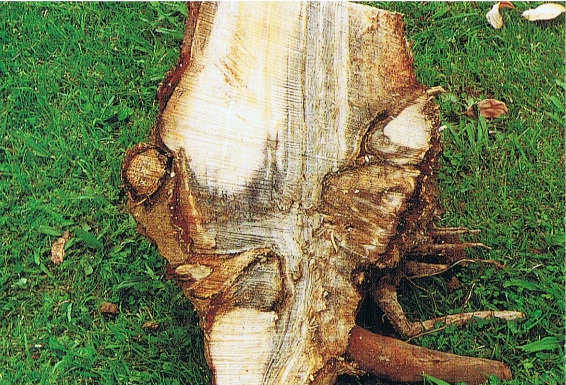PESTS AND DISEASES OF FORESTRY IN NEW ZEALAND
Leptographium in radiata pine
From Forest Health News 140, May 2004.
When Pinus radiata trees are felled and left too long in the forest, undesirable blue or blackish discoloration soon develops in the sapwood, degrading the sawn timber and reducing its value. Sap stain is caused by the growth within the sapwood of certain dark-coloured fungi belonging to a number of different species and genera. Most of those identified in New Zealand-grown P. radiata are also known from conifer species in the Northern Hemisphere.

Although some are true saprophytes that can spread only within the sapwood once the tree has been cut down, others are also implicated as agents of root and stem disease. One important genus of sapstain fungi is Leptographium , which, with a steady stream of additions described in recent years, now contains over 40 species. The first species of Leptographium to be found in New Zealand was L. procerum , isolated in 1976 from extensive blue-stained wood in the roots and butts of dead and dying trees associated with wet soil conditions in a stand of P. strobus growing in Hawke’s Bay.
The L. procerum complex has been widely investigated overseas. This group of fungi has been associated with root decline of P. strobus in Europe and North America and also occurs on a wide range of other conifers. However, their role in tree death has been a matter of debate, since pathogenicity tests performed with isolates of these fungi have yielded contradictory results.
In each case where there has been evidence of pathogenicity, the affected trees have also been subjected to some form of stress, such as unfavourable soil moisture levels, air pollution, insect infestation, or root disturbance.
A number of isolates of Leptographium assigned to L. procerum are somewhat atypical in their cultural characteristics and the need for a taxonomic review has been recognised for a long time. In a recent evaluation of 29 of these isolates three new species were separated from L. procerum and formally named and described. Two are present in New Zealand, Leptographium euphyes, which has been recorded only in this country, and L. alethinum, which has also been found in England. Nothing definite is known about the pathogenic capability of either of these species in New Zealand. They have often been found in roots of dying pines (particularly P. strobus as well as P. radiata) along with other blue-stain fungi, and generally occur where site conditions are less than favourable. Episodic waterlogging of the soil is a common site characteristic when Leptographium species are present in the lower stem or roots, or both. They are also often found in association with insects such as the European bark beetles Hylastes ater and Hylurgus ligniperda , and it is
possible that they were carrying Leptographium species as contaminants at the time of their introduction.
Five species of Leptographium are now known to occur in New Zealand. Besides L. procerum , L. alethinum , and L. euphyes, two other widely distributed species are L. lundbergii and L. huntii. In our investigation of root and butt infections it is not unusual to find several species of Leptographium together in the same stem.
(Margaret Dick, Forest Research)

 Farm Forestry New Zealand
Farm Forestry New Zealand

